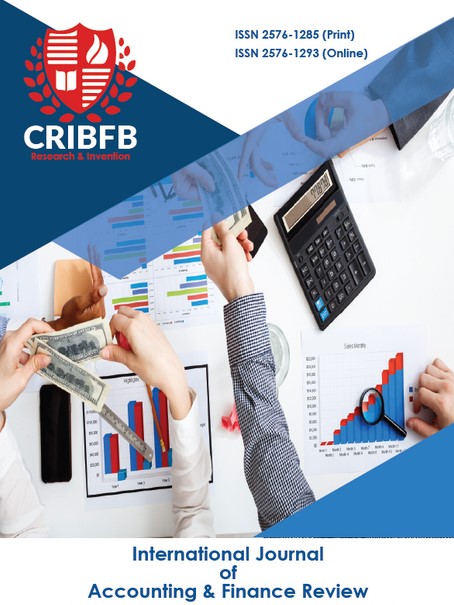DEMONETIZATION AND IMPROVISATION OF VALUE CHAIN DYNAMIC IN AFGHANISTAN: AN EXPLORATORY STUDY
Main Article Content
Abstract
Demonetization is the elimination of the backing of the money granted by law to the notes is, therefore, legal tender. On Wednesday_ September 2002, the new president of the transition government announced from television to the people of Afghanistan that the decision had been reached in response to Afghan and foreign experts. They had advised the new Government to replace the currency and reform Afghanistan’s banking system. “This will help in controlling the massive inflation and stabilize the economy. A survey was conducted with a pre-tested questionnaire among the common public in Kabul and Parwan’s main two provinces to collect their views on factors associated with demonetization in Afghanistan. PCA (Principal component analysis) technique has been used for factor extraction and dimension reduction using the Varimax orthogonal rotation. The top key factors related to the implementation of demonetization have been identified as socio-economic factors, public hardships, challenges, and implementation challenges. The survey data’s descriptive analysis shows that most survey respondents either ‘strongly agree’ or ‘agree’ with the 19 measures on perception and opinion of the common man (general public) on demonetization in Afghanistan.
Downloads
Article Details
Section
How to Cite
References
Bennett, A. (2003). Islamic State of Afghanistan: Rebuilding a Macroeconomic Framework for Reconstruction and Growth. International Monetary Fund.
Briceno, A. J. H., & de Hurtado, S. Z. (2019). India-Venezuela: Analysis of Demonetization Measures. International Journal of Advances in Management and Economics, 8(2), 11. Retrieved from https://www.researchgate.net/publication/332233986.
Cattell, R. B. (1966). The Screen Test For The Number Of Factors. Multivariate Behavioral Research, 1(2), 245–276. https://doi.org/10.1207/s15327906mbr0102_10
Chandrasekhar, C. P., & Ghosh, J. (2018). The Financialization of Finance? Demonetization and the Dubious Push to Cashlessness in India: Debate: The Financialization of Finance in India. Development and Change, 49(2), 420–436. https://doi.org/10.1111/dech.12369
Chodorow-Reich, G., Gopinath, G., Mishra, P., & Narayanan, A. (2020). Cash and the Economy: Evidence from India’s Demonetization*. The Quarterly Journal of Economics, 135(1), 57–103. https://doi.org/10.1093/qje/qjz027
Chawla, D., & Sondhi, N. (2016). Research Methodology Concept and Cases (Second Edition). Vikas Publishing House PVT LTD.
DAB. (2006). Quarterly Economic and Statistical Bulletin Combined Quarterly Issue (2005-06). Monetary Policy Department of Da Afghanistan Bank. Retrieved from https://dab.gov.af/sites/default/files/2019-01/DABQuarterlyBulletin-CombinedIssue1384%282005-2006%29.pdf
Dash, A. (2017). A Study on Socio-Economic Effect of Demonetization in India. International Journal of Management and Applied Science,3(3), 4. Retrieved from http://iraj.in/journal/journal_file/journal_pdf/14-349-149485006913-15.pdf.
DeVellis, R. F. (2016). Scale Development: Theory and Applications11 (Fourth Edition). SAGE Publications.
Focus on the introduction of a new currency. (2002, September 5). The New Humanitarian. Retrieved from https://www.thenewhumanitarian.org/feature/2002/09/05/focus-introduction-new-currency
Ghani, A., & Lockhart, C. (2008). Fixing failed states: A framework for rebuilding a fractured world. Oxford University Press.
Ghosh, J., Chandrasekhar, C. P., & Patnaik, P. (2017). Demonetisation decoded: A critique of India’s currency experiment. Routledge.
Ghosh, S. (2016). Productivity, ownership, and firm growth: Evidence from Indian banks. International Journal of Emerging Markets, 11(4), 607–631. https://doi.org/10.1108/IJoEM-05-2015-0096
Hair, J. F., Black, W. C., Babin, B. J., Anderson, R. E., & Tatham, R. L. (1998). Multivariate data analysis (Vol. 5, No. 3, pp. 207-219). Upper Saddle River, NJ: Prentice hall.
Kaiser, H. F. (1960). The application of electronic computers to factor analysis. Educational and Psychological Measurement, 20(1), 141–151.https://doi.org/10.1177/001316446002000116
Kaiser, H. F. (1974). An index of factorial simplicity. Psychometrika, 39(1), 31–36. https://doi.org/10.1007/BF02291575
Knaap, P.V.D., Vries, T. D., & Boesenach, E. (2018). World Cash report (p. 196). Retrieved from https://cashessentials.org/app/uploads/2018/07/2018-world-cash-report.pdf
Kumar, P. (2017). Demonetization and its Impact on Adoption of Digital Payments: Opportunities, Issues, and Challenges. Abhinav National Monthly Refereed Journal of Research in Commerce & Management. 6(6), 15. Retrieved from https://www.researchgate.net/publication/317283897
Mahajan, P., & Singla, A. (2017). Effect of Demonetization on Financial Inclusion in India. International Journal of Science Technology and Management (IJSTM).Vol. No.6,(Issue No.01), 6. Retrieved from https://www.ijstm.com/images/short_pdf/1484056964_N360_IJSTM.pdf.
Mukherjee, R. (2019). Jio sparks Disruption 2.0: Infrastructural imaginaries and platform ecosystems in ‘Digital India.’ Media, Culture & Society, SAGE Publication, 41(2), 175–195. https://doi.org/10.1177/0163443718818383
Nair, A. K. S., & Bhattacharyya, S. S. (2019). Is sustainability a motive to buy? An exploratory study in the context of mobile applications channel among young Indian consumers. Emerald Insight Foresight, 21(2), 177–199. https://doi.org/10.1108/FS-05-2018-0048
Netemeyer, R. G., Bearden, W. O., & Sharma, S. (2003). Scaling Procedures: Issues and Applications. SAGE Publications.
Panah, A. M., & Muniraju, Y. (2019). Demonetization, economic restructuring, and monetary sustainability in war-prone Afghanistan. Asian Journal of Multidimensional Research (AJMR), 8(3), 509. https://doi.org/10.5958/2278-4853.2019.00127.7
Prasad, S. R. (2019). Measuring the efficiency of indian real estate firms during the pre-and post-demonetization period by adopting data envelopment analysis. Baltic Journal of Real Estate Economics and Construction Management, 7(1), 98-109.
Ramchandra Gowda, M., Aswatha Narayana, T., Ravi, M. V., & Srinivas, K. T. (2014). Monetary System (Second Revised Edition). Himalaya Publishing House Pvt Ltd. Retrieved from www.himpub.com
Sharma, C. (2019). Estimating the size of the black economy: New evidence from India. International Journal of Emerging Markets, 14(2), 300–321. https://doi.org/10.1108/IJoEM-01-2018-0034
Singh, P., Sawhney, R. S., & Kahlon, K. S. (2018). Sentiment analysis of demonetization of 500 & 1000 rupee banknotes by the Indian government. ICT Express, 4(3), 124–129. https://doi.org/10.1016/j.icte.2017.03.001
Sivathanu, B. (2019). Adoption of digital payment systems in the era of demonetization in India: An empirical study. Journal of Science and Technology Policy Management, 10(1), 143–171. https://doi.org/10.1108/JSTPM-07-2017-0033
Swain, D. R. K., & Das, C. P. (2018). Economic Consequences of Demonetization : A Comparative Analysis. Orissa Journal of Commerce, Vol.III, pp 1-7, 103. Retrieved from https://ojcoca.org/jan18.pdf.
Singh, K. Y. (2006). Fundamental of Research Methodology and Statistics. New Age International (P) Limited, Publishers. Retrieved from www.newagepublishers.com.
Thakur, R., & Srivastava, M. (2013). Customer usage intention of mobile commerce in India: An empirical study. Journal of Indian Business Research, 5(1), 52–72. https://doi.org/10.1108/17554191311303385
Vij, D. D. (2018). Demonetization: Effects on the Indian Economy. International Research Journal of Business and Management- IRJBM, Volume No – XI(Issue – 1), 11. Retrieved from http://irjbm.org/irjbm2013/Jan18/Abstract15.pdf.




